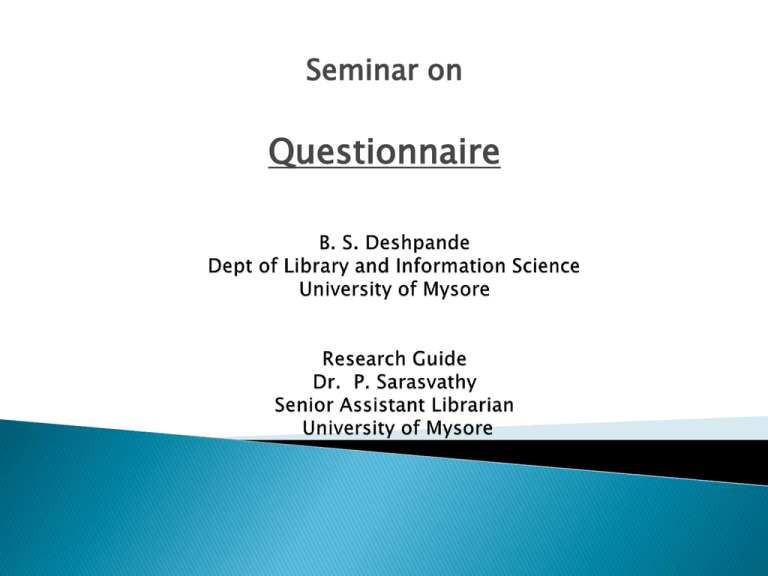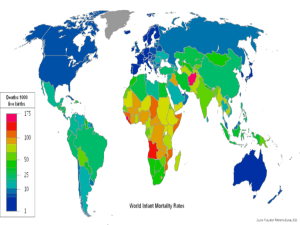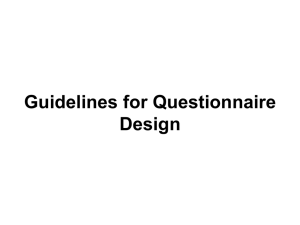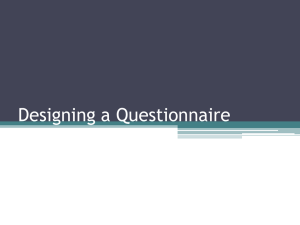Questionnaire - University of Mysore
advertisement

Seminar on Questionnaire INTRODUCTION A questionnaire is a data-gathering device. Questionnaires are flexible and adaptable to a variety of research designs, populations and purposes. A questionnaire comprises of series of questions asked from the respondents in order to investigate any phenomenon, its use is more common in research studies and in statistics. The First questionnaire was first developed by Sir. Francis Galton. Cont…. Questionnaire is basically one of the type of survey which is a method in primary research. Questionnaire is one of the most commonly used method in survey. Since other two methods that are interview and observation are rather difficult to conduct as compared to questionnaire. Questionnaires can be conducted for any type of research study, but their use is common in social sciences, humanities and in management studies. where one has to know the opinion of people regarding anything. A questionnaire is a formalized set of questions for obtaining information from respondents. It must translate the information needed into a set of specific questions that the respondents can and will answer. A questionnaire must uplift, motivate, and encourage the respondent to become involved in the interview, to cooperate, and to complete the interview. A questionnaire should minimize response error. Survey questions can be Classified into two Structures Closed – ended Open – ended Openended Slow Speed of completion Closed Fast High Exploratory nature Low High Breadth and depth Low Easy Ease of preparation Difficult Difficult Ease of analysis Easy There are nine steps involved in the development of a questionnaire: 1. Decide the information required. 2. Define the target respondents. 3. Choose the method(s) of reaching your target respondents. 4. Decide on question content. 5. Develop the question Structures. 6. Put questions into a meaningful order and format. 7. Physical appearance of the questionnaire. 8. Pre-test the questionnaire. 9. Develop the final survey form. Questionnaire language should be ◦ ◦ ◦ ◦ ◦ ◦ ◦ Simple Specific Free of bias Not patronizing Technically accurate Addressed to those who are knowledgeable Appropriate for the reading level of the respondent It is important to design questions very carefully. A poorly designed questionnaire renders results meaningless. There are many factors to consider. Make items clear. Avoid double-barreled questions. Respondent must be competent to answer. Questions should be relevant. Short items are best. Avoid negative items. Number of questions to be added in a questionnaire depends on various factors, but one thing is sure that a questionnaire that contain too many questions will not be very effective. Still it depends on the type of study and the target population. A population that has low mental I.Q. will face problems in answering too many questions but a questionnaire that has to be submitted to an educated population will know that the questions should be answered in proper manner. The sequence of questions questionnaire should be logical. in the Try to think from respondent's point of view. Bold questions should be asked at the end. Check the spellings of the question statements before printing. Do not use offensive language in the questionnaire. Sometimes consciously or unconsciously we write question statements that carry double-meanings such questions will not get right responses. If their are any difficult terms in the questionnaire than do explain them. Cont…. Avoid unnecessary questions a long questionnaire. Know the academic and mental capacities of the target population and design questions accordingly. If their are certain personal or emotional questions ask them in the middle or at the end. Don't ask for elaborate answers for the questions Cont… Use polite language. Don't write questions that already contain the answer to the question. Prefer neutral questions rather confirmatory or negative questions. than using Let the respondents know that their privacy will be ensured and their name and other information will not be leaked. In close-ended questions provide enough options to choose from. A well designed questionnaire is essential to a successful survey. A good questionnaire is one which help directly achieve the research objectives, provides complete and accurate information, is easy for both interviewers and respondents to complete. Kothari, C. R. (2008). Research methodology. (2 ed., p. 418). New Delhi: New Age Publications. Krishnaswamy , O. R. (2002). methodology of research in social science . (p. 529). Delhi: Himalaya Publishing house. Ronald , R. P., & Lynn , S. C. (2004). Basic research methods for librarians (library and information science text series). (4 ed., p. 200). New Delhi: Libraries Unlimited. Kenneth , N. R. (2005). Quantitative research methods in educational planning. Retrieved from http://unesdoc.unesco.org/images/0021/002145/214555E.pdf









